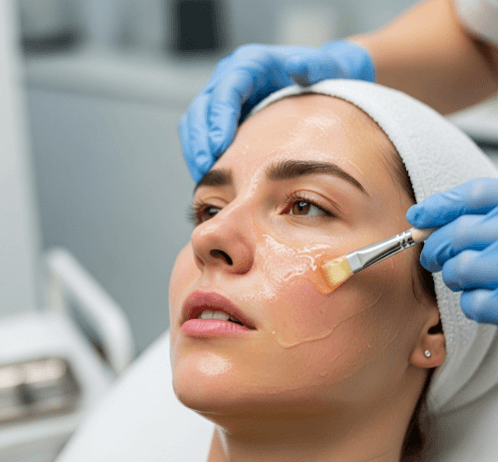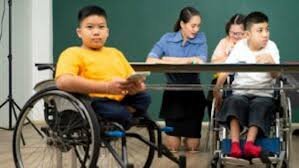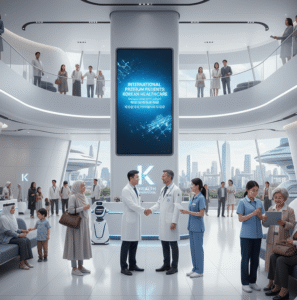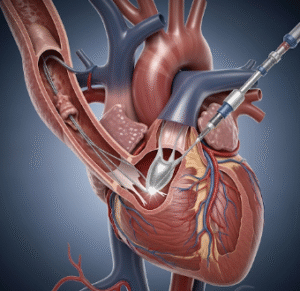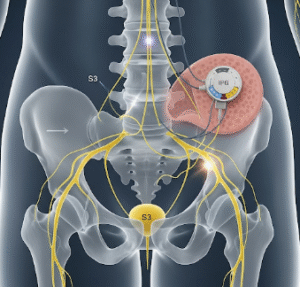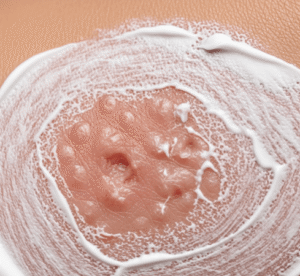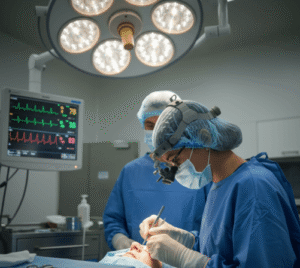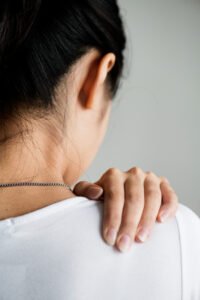What It Is
Chemical resurfacing is a cosmetic dermatology procedure that uses chemical solutions to exfoliate and regenerate the skin by removing its outer layers. This process encourages new, smoother, and healthier skin to emerge. The term is often synonymous with chemical peels, but “resurfacing” can refer to a broader range of treatments that go beyond light peels and penetrate deeper layers for more dramatic results.
The strength and depth of chemical resurfacing vary:
- Superficial peels → Use mild acids (like glycolic, lactic, or mandelic acid) to exfoliate the epidermis.
- Medium-depth peels → Use stronger agents (like trichloroacetic acid, TCA) to target both the epidermis and upper dermis.
- Deep peels → Use phenol or high-concentration TCA, penetrating deeply to treat severe wrinkles and sun damage.
In Korea, chemical resurfacing is often performed in a customized, layered way — tailored to each individual’s skin type and concerns — and may be combined with hydrating therapies or laser treatments for safer and more effective results.
Why It’s Done
Patients undergo chemical resurfacing for a variety of aesthetic and medical reasons:
➝ Anti-aging → Reduces fine lines, wrinkles, and age spots.
➝ Acne & acne scars → Clears clogged pores, reduces active breakouts, and minimizes scarring.
➝ Hyperpigmentation → Treats melasma, sunspots, and uneven skin tone.
➝ Sun damage → Repairs photoaging effects like rough texture and discoloration.
➝ Skin texture refinement → Smooths rough patches and enlarged pores.
➝ Overall glow → Creates brighter, more youthful-looking skin.
In Korea, the motivation often goes beyond “fixing problems.” Many patients seek resurfacing treatments preventively or for maintenance, aligning with the K-beauty philosophy of achieving clear, smooth, and radiant skin at every age.
Alternatives
While chemical resurfacing is highly effective, other treatments can offer similar benefits depending on the patient’s needs:
- Laser resurfacing (Fraxel, CO₂ lasers) → Uses energy instead of chemicals to resurface skin.
- Microneedling (with or without RF) → Creates micro-injuries to stimulate collagen.
- Microdermabrasion → Mechanical exfoliation of the uppermost skin layers.
- Topical retinoids or acids → Gentle, at-home alternatives for long-term exfoliation.
- Hydrafacial or Aqua Peeling → Non-invasive hydration and exfoliation treatments.
In Korea, dermatologists often recommend combination approaches. For example:
- Mild chemical resurfacing + exosome therapy for faster healing.
- TCA peel + fractional laser for acne scars.
- Superficial glycolic peel + hydrating facial for maintenance.
Preparation
To ensure both safety and optimal results, preparation before chemical resurfacing is essential:
➝ Skin analysis → Korean clinics use digital scanners to measure pigmentation, pores, and sun damage.
➝ Medical history → Patients disclose medications (especially isotretinoin, blood thinners) and skin conditions.
➝ Pre-conditioning routine → Topical retinoids, vitamin C, or hydroquinone may be prescribed for 2–4 weeks before medium/deep peels.
➝ Avoid sun exposure → Patients should minimize UV exposure and avoid tanning for at least 4 weeks before treatment.
➝ No harsh skincare → Stop retinoids, exfoliants, and strong acids 5–7 days prior.
➝ Antiviral medication → Sometimes prescribed to patients with a history of cold sores before deeper peels.
In Korea, preparation often includes hydrating and calming facials before the peel to reduce irritation and maximize healing afterward.
How It’s Done
The chemical resurfacing process varies depending on peel depth but generally includes the following steps:
- Cleansing
- Skin is thoroughly cleansed to remove oils, dirt, and makeup.
- Application of solution
- A chemical agent (glycolic acid, salicylic acid, TCA, or phenol) is carefully applied with gauze, brush, or cotton swab.
- Patients may feel tingling, warmth, or mild stinging.
- Monitoring reaction
- Dermatologists observe frosting (white patches on the skin) or color change to gauge penetration depth.
- Neutralization or removal
- Superficial and medium peels are neutralized after a set time.
- Deep peels may not require neutralization but need careful monitoring.
- Post-treatment soothing
- Cooling packs, LED therapy, or soothing creams are applied.
- Sunscreen is always the final step.
Duration → 20–60 minutes depending on peel depth.
Treatment plan →
- Superficial peels: 3–6 sessions, 2–4 weeks apart.
- Medium peels: 1–3 sessions, 4–6 months apart.
- Deep peels: One-time, but long-lasting effects.
Recovery
Recovery time depends on the depth of the peel:
- Superficial peel → 1–3 days of mild redness and flaking.
- Medium peel → 5–7 days of redness, peeling, and slight swelling.
- Deep peel → 2–3 weeks of redness, swelling, and crusting before full recovery.
Aftercare guidelines:
➝ Apply SPF 50+ sunscreen daily.
➝ Keep skin moisturized with soothing creams.
➝ Avoid picking or peeling skin manually.
➝ Refrain from hot baths, saunas, or vigorous exercise for 3–5 days.
➝ Avoid makeup until the skin barrier has healed.
In Korea, aftercare is enhanced with soothing sheet masks, stem cell serums, or exosome boosters, which accelerate recovery and reduce downtime.
Complications
While generally safe, chemical resurfacing carries potential risks, especially with medium-to-deep peels:
➝ Redness & irritation → Common, usually temporary.
➝ Hyperpigmentation or hypopigmentation → More likely in darker skin tones without proper preparation.
➝ Scarring → Rare, but possible if the skin is not cared for during recovery.
➝ Infection → Bacterial or viral infections can occur if aftercare is neglected.
➝ Allergic reaction → Rare, depending on the chemical used.
Korean dermatologists minimize these risks through personalized peel selection, patch testing, and post-care support.
Treatment Options in Korea
Korea is globally recognized for its advanced, safe, and innovative resurfacing techniques.
1. Types of Peels Used in Korea
- Glycolic acid peels → Popular for brightness and acne-prone skin.
- Mandelic acid peels → Gentler option for sensitive skin.
- Salicylic acid peels → Effective for acne and oily skin.
- TCA peels → Used for scars, pigmentation, and deeper wrinkles.
- Combination peels (Jessner’s, modified TCA blends) → Custom blends for complex skin issues.
2. Korean Innovations
- Aqua Peeling → Combines light chemical peel with hydration infusion.
- Layered peels → Dermatologists apply multiple acids at varying concentrations for precision results.
- Hybrid therapies → Laser + mild peel + exosome serum for enhanced rejuvenation.
Final Thoughts
Chemical Resurfacing in Korea is more than just exfoliation — it is a scientifically guided rejuvenation method tailored to individual skin needs. Whether it’s for acne scars, wrinkles, pigmentation, or overall glow, Korean dermatologists excel at using customized peel blends, advanced aftercare, and integrated programs to ensure safe and natural-looking results.
With Korea’s emphasis on preventative skincare and minimal downtime, chemical resurfacing remains a cornerstone treatment for achieving the radiant, smooth, and youthful skin that K-beauty is famous for.

